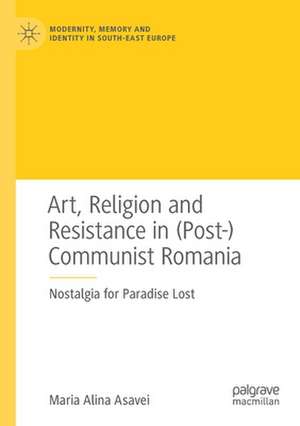Art, Religion and Resistance in (Post-)Communist Romania: Nostalgia for Paradise Lost: Modernity, Memory and Identity in South-East Europe
Autor Maria Alina Asaveien Limba Engleză Paperback – 24 oct 2021
| Toate formatele și edițiile | Preț | Express |
|---|---|---|
| Paperback (1) | 386.81 lei 6-8 săpt. | |
| Springer International Publishing – 24 oct 2021 | 386.81 lei 6-8 săpt. | |
| Hardback (1) | 393.13 lei 6-8 săpt. | |
| Springer International Publishing – 23 oct 2020 | 393.13 lei 6-8 săpt. |
Din seria Modernity, Memory and Identity in South-East Europe
- 17%
 Preț: 523.82 lei
Preț: 523.82 lei - 15%
 Preț: 702.05 lei
Preț: 702.05 lei - 15%
 Preț: 471.69 lei
Preț: 471.69 lei - 15%
 Preț: 502.54 lei
Preț: 502.54 lei - 15%
 Preț: 584.26 lei
Preț: 584.26 lei -
 Preț: 380.84 lei
Preț: 380.84 lei - 18%
 Preț: 780.37 lei
Preț: 780.37 lei - 18%
 Preț: 786.36 lei
Preț: 786.36 lei - 15%
 Preț: 499.59 lei
Preț: 499.59 lei - 18%
 Preț: 892.11 lei
Preț: 892.11 lei - 15%
 Preț: 581.14 lei
Preț: 581.14 lei - 18%
 Preț: 887.68 lei
Preț: 887.68 lei - 18%
 Preț: 780.82 lei
Preț: 780.82 lei - 15%
 Preț: 643.16 lei
Preț: 643.16 lei - 15%
 Preț: 698.80 lei
Preț: 698.80 lei
Preț: 386.81 lei
Nou
74.03€ • 76.100$ • 61.11£
Carte tipărită la comandă
Livrare economică 15-29 aprilie
Specificații
ISBN-10: 3030562573
Pagini: 309
Ilustrații: XIV, 309 p. 23 illus., 20 illus. in color.
Dimensiuni: 148 x 210 mm
Greutate: 0.39 kg
Ediția:1st ed. 2020
Editura: Springer International Publishing
Colecția Palgrave Macmillan
Seria Modernity, Memory and Identity in South-East Europe
Locul publicării:Cham, Switzerland
Cuprins
Contents
1. Art, Politics and Religion in (Post-) Communist Romania: An Introduction
2. On the Varieties of Cultural Resistance during Romanian Late Communism
3. Godless Religious Art of Romanian National Communism
4. Art, Nature and Ecologies of Transfiguration during Romanian National Communism
5. Spiritual Ecologies and Meta-Byzantine Music during Nicolae Ceauṣescu’s Regime
6. Contemporary Aesthetic Mysticism and Religious Revitalization Movements
7. The Body in (Post-) Communist Art: a Site of Salvation and Resistance
8. Religion Inspired Art and Politics: Neo-Orthodoxism as Neo-Traditionalism?
9. Art as Resistance to the “Religious Affair” and Consumerist Religion in Post-Communist Romania
10. Looking Forward: Looking Back through the Three Lenses of Art, Politics and Religion
Index
Notă biografică
Maria-Alina Asavei is Senior Lecturer at the Institute of International Studies at Charles University in Prague, Czech Republic, and an independent curator of contemporary art.
Textul de pe ultima copertă
Caracteristici
Spans the fields of contemporary history, political theory, history of religion, art history and theory, and memory studies
Explores the multifarious connections between religion, politics and artistic production
